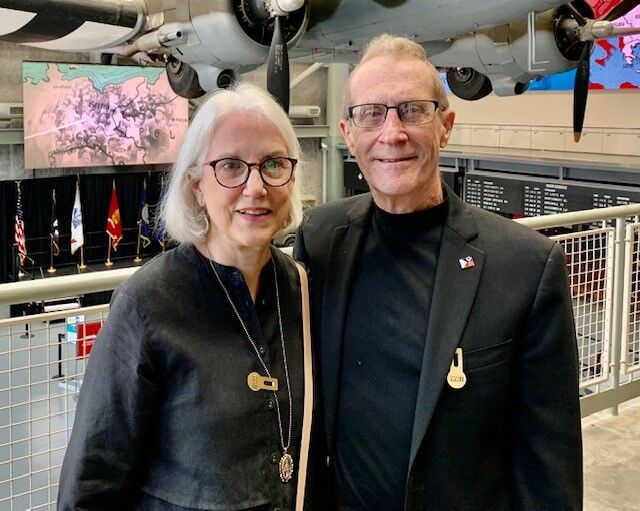Searching for the Lost Acadian Settlement: A can’t-miss event!
Published 3:00 am Thursday, September 1, 2022

- Mary and Warren Perrin, authors, cultural activists and founders of the Acadian Museum in Erath, Louisiana.
A ‘Search for the Lost Acadian Settlement’ presentation along with cajun music is part of an exciting event at The Acadian Museum on Sept. 14.
Andy Perrin, Chairman of the Acadian Museum’s Executive Committee, explained it’s more than just music and displays.
The event will take place Wednesday, Sept. 14 at 10 a.m. at the Jean Lafitte National Park at 419 Decatur St. in New Orleans.
“The Acadian Museum of Erath announces that Warren and Mary Perrin will be doing a PowerPoint presentation on the ‘New Acadia Project: Searching for the Lost Acadian Settlement’ in New Orleans,” Perrin said. “Please spread the word among your friends and contacts and encourage them to spread the word and, if possible, attend the event.”
Bruce Daigrepont, singer, songwriter and accordionist, will play Cajun music for the event.
Daigrepont has performed at Tipitina‘s nightclub on Napoleon Avenue in New Orleans for over 30 years.
He is the record-holder for the most performances at Tipitina’s nightclub. Daigrepont has hosted over 1400 fais-doo-doo—a Cajun dance party—on Sunday evenings.
Andy Perrin provided us with a summary to get you ready for the event:
Historical Summary: October 20, 2021, was the 256th anniversary of the death of a man that many consider the father of Cajun culture: Joseph “Beausoleil” Broussard. A group of about 200 Acadians, led by Broussard, arrived by ship at the port of New Orleans shortly before February 19, 1765, as determined by the first baptism of a child of Pierre and Marie Bourgeois, Michel Daroy, recorded in the Archdiocese of New Orleans Sacramental Records.
The arrival of the Acadians was also reported in a letter dated February 25, 1765, from Charles-Phillipe Aubry, acting governor of the Louisiana Territory, to the Duke of Choiseul-Stanville, secretary of the French Ministry. It was reported that the first thing the group did was to kneel in prayer – and then to dance. On April 4, 1765, the Acadians entered into a compact with Antoine Bernard Dauterive to raise cattle in the Attakapas District, now St. Martin and Iberia parishes. It was signed by eight Acadian Chiefs: Joseph Beausoleil Broussard, Alexandre Broussard, Joseph Guilbeau, Jean Duga, Olivier Tibaudau, Jean Baptiste Broussard, Pierre Arceneaux and Victor Broussard. The main reason the Acadians were sent to the Attakapas Territory was to raise cattle—and thereby provide meat to New Orleans.
According to archival records, Joseph Beausoleil Broussard was named Captain Commandant of the Acadians in the Attakapas Territory on April 8, 1765, by the colonial governor.
On April 15, 1765, Lt. Andry was given an assignment to lead the Acadians to the Attakapas Territory and help them to settle in. On April 24, 1765, in a letter to Choiseul, Aubry explained why he sent the Acadians to the Attakapas District and the route to be taken. Regrettably, the map that the governor ordered Lt. Andry to make showing the location of the first settlement has never been found. Archaeologists searching for the original settlement call it the “Lost Colony of New Acadia.”
According to the burial record found in the archives of St. Martin de Tours Catholic Church in Saint Martinville, six months after he arrived in the Attakapas Territory, on October 20, 1765, “Beausoleil” died. Burial services were performed by Fr. Jean-Francois de Civrey. The place of burial, however, is not known. The priest merely referred to it as Camp Beausoleil. Because the Acadians had just arrived in the wilderness of the Attakapas Territory and were being decimated by an epidemic disease, probably small pox, the locations near the burial sites were described as “camps.” According to church records, Beausoleil’s brother Alexandre Broussard had been buried earlier. Approximately 40 Acadian settlers died in the epidemic. The locations of all three burial sites remain a mystery.
Currently, an archaeological expedition known as the New Acadia Project (NAP) is seeking to locate, identify and investigate the 18th-century homesteads and now-unmarked graves of the first Acadian exiles of present-day Iberia parish. The project is spearheaded by University of Louisiana at Lafayette archaeologist Dr. Mark Rees. Reese and his crew have now identified at least eight sites along the Teche Ridge that date from the 18th century. Remote sensing continues on those sites.
Rees said archaeological sampling has produced ceramic sherds manufactured during the 1750s, which were found near the surface and also in deposits more than three feet deep. According to Rees, continuity in the use of graveyards is assumed. This hypothesis may lead archaeologists to the unmarked graves of the Acadians and also their homesteads—referred to by Fr. Jean-Francois de Civrey as Nouvelle Acadie or New Acadia. Persons interested in learning more about the initial Attakapas Acadian settlement can read, “A New Look at the Initial Acadian Settlement Location in the Attakapas” by Donald J. Arceneaux





